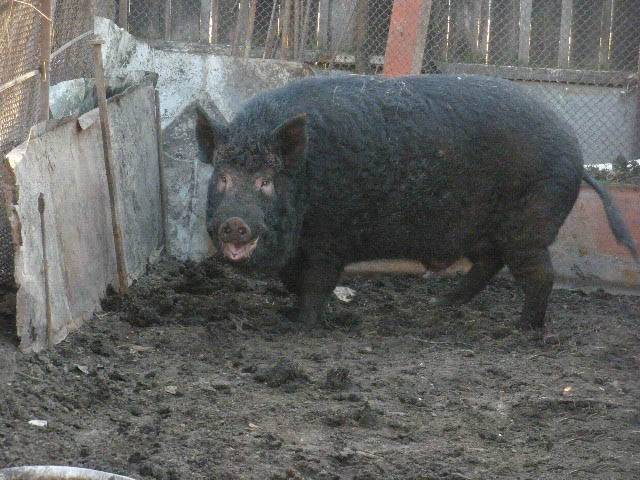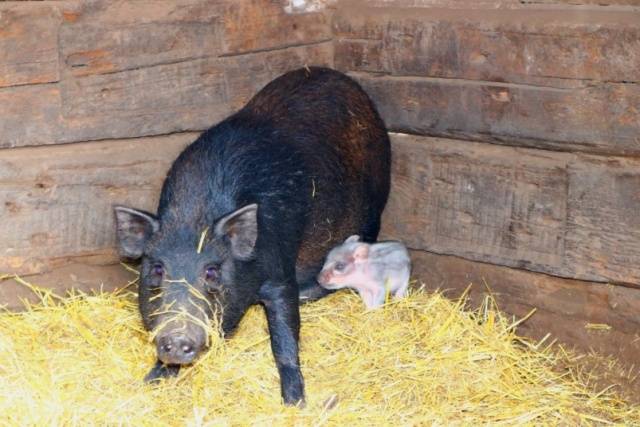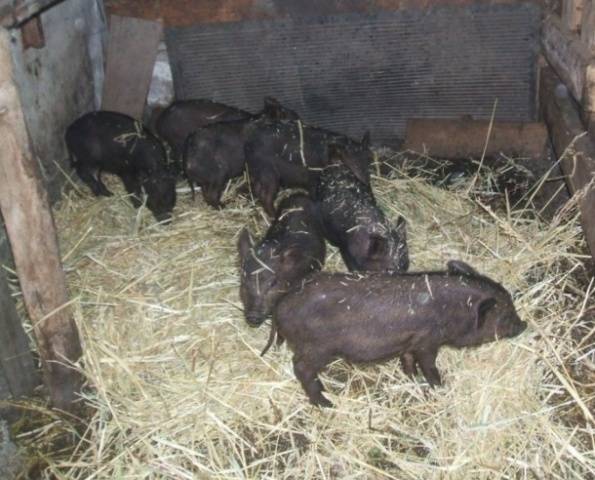Content
Karmals are not pig breed in fact, but a heterotic hybrid between Mangal and Vietnamese pot bellies. The offspring from crossing as a result of heterosis has better productive qualities than the original breeds. But the appearance of animals is obtained on the principle of "how the genes will fall."
You can even compare photos of Karmal pigs:
On the first, the appearance of Karmala is closer to Mangal. In the second photo, Karmal has obvious features of a Vietnamese vismoth. But the wool is somewhat thicker.
If we remember that Mangal is also a hybrid between the Hungarian mangalitsa and a wild boar, then sometimes the result of such "double hybridization" is impressive. And it's good if you impress a pig of the Karmal breed, it will be productive characteristics and tasty meat, and not the character and habits of a wild boar.
Who is Karmal
First of all, I have to mention that sometimes Karmala is called a hybrid with a Korean pig. This opinion raises some doubts, since although the Korean pigs are close relatives of the Vietnamese one and also descend from the wild Chinese boar, the “Koreyanka” are little known in the world.
In Korea, these animals were kept for a long time as utilizers of human waste, and they are still poorly known in the world. Only from the 60s of the last century, the diet of Korean pigs began to be changed to a more civilized one, and for keeping, instead of a pit under a latrine, they began to build pigsties.
On the territory of the CIS, there is no distinction between the Vietnamese and Korean breeds. And if you add here various Chinese breeds, also descended from the same wild Chinese boar, you can get completely confused.
Karmaly pigs are of two types: the F1 Mangala / Korean hybrid and the backcross hybrid. Second option: F1 is crossed with Mangal again. For this reason, despite the effect of heterosis, Karmal's weight can be very different. Vietnamese reach a maximum weight of 150 kg. Braziers can weigh 300 kg. An adult F1 hybrid weighs 220 kg. Where is the effect of heterosis? Improving the quality of meat. If you need to get a larger animal, F1 is crossed again with Mangal. The weight of the resulting pig Karmala in six months already reaches 150 kg. The taste characteristics of the meat of the Karmal pig breed with 75% Mangal blood is better than that of the original breeds, but in appearance this cross is already difficult to distinguish from Mangal.
The main difficulty with a hybrid is that from a photo and even a live pig Karmala is easy to confuse with a Vietnamese or Mangal. This is used by unscrupulous breeders, selling Vietnamese piglets, which have become much cheaper today, under the guise of expensive Karmals.
The only guaranteed way to get exactly Karmala is to cross the Mangala sow with a Vietnamese boar yourself. To obtain the second version of Mangala, it will be necessary to cross a Mangala sow with an F1 boar.
Benefits of Karmala
Karmal combines the positive qualities of the Vietnamese pig and Mangala. With full feeding, Karmal reaches sexual maturity at 4 months, like the Vietnamese pot bellies. By the year Karmal reaches 200 kg, like Mangal.
The big question is who this breed has the advertised low amount of lard.According to the owners of Karmalov piglets, after slaughter, no one has a layer of fat more than 3 fingers. It is the Vietnamese pigs that are distinguished by a relatively small amount of gained lard.
None of the original breeds has this property. You can get lean meat from Vietnamese if you keep them "on a diet" without giving them grains. But the bacon still adheres tightly to the meat and must be cut off.
Mangals inherited from Mangalits the ability to store fat between muscle fibers. With high-quality fattening, they also gain fat well and must also be cut off.
Karmal's frost resistance is clearly from the Mangal breed. Karmals, like Mangals and Hungarian Mangalits, can be kept outdoors in winter. They have a thick enough coat to withstand the winter cold.
An agreeable and good-natured character is often indicated as advertising in the merits. But this is how lucky and how tame the animal will be. The wild boar is the most dangerous inhabitant in the forest. Neither tigers, nor wolves, nor bears associate with adults. If the wild boar genes "jump" in Karmal, then he will hardly be docile and good-natured.
Another plus is called strong immunity, which supposedly does not require vaccinations. A very dangerous delusion that contributes to the spread of epizootics.
Piglets, are there any differences
On the external and productive characteristics of Karmalov piglets, the information is also quite contradictory. Some sources claim that all Karmalyats are born striped, like wild boars. Others argue that the color at birth of piglets of the Karmal breed can be almost any:
- striped;
- "Smooth" gray;
- redhead;
- black.
There are no only statements about the birth of white or piebald pigs. Which is rather strange, since there are photos of Karmalov piglets of piebald or white color next to one-color striped brethren.
It can be assumed that this is a photo of a mixed herd of piglets of different breeds. But a photo of a piebald sow of the Karmal breed with piglets refutes this assumption. Piebald not only a sow, but also the piglets themselves.
With age, the stripes disappear in piglets, as in wild boar.
According to reviews about Karmaly pigs, they can be kept in an open pen in the winter from the age of one month. But if you need not just a piglet of an exotic breed, but a fattened pig, it is better not to keep the young in such conditions. Even in young wild animals in winter, in cold weather, growth slows down or stops altogether. Young growth begins to grow again only with the onset of warmth.
For wild animals, daily weight gain is not interesting, but for humans it is very important. Keeping a piglet for up to a year instead of 6 months is unprofitable. Therefore, feeding and caring for Karmal piglets is the same as for young animals of other breeds.
Even the video shows that due to the fact that piglets are hybrids, littermates have very strong differences. The productive characteristics will also be different.
Content
Adult Karmals can indeed be kept outdoors, providing them with a shelter from the rains. Piglets during the period of intensive growth require a closed room, where the temperature will not fall below 15 ° C. For both adults and young animals, straw is laid on the floor, in which the pigs can burrow to keep warm.
Feeding
How to feed Karmal depends on the goals of his maintenance. In the ration of a fattening animal, grain feed and grain feed predominate.
No, Karmals are not herbivorous pigs as advertised on many sites. They are omnivores. Like any omnivorous animal, for normal digestion, they need fiber, which they get from grazing grass in the summer. In winter, Karmals need to be given root vegetables and other vegetables.
Karmals will be able to live on one grazing forage, but in this case there is no need to expect productivity from them. Their diet should also contain animal proteins, which pigs can get from dairy products. You can also add meat and bone meal to the diet. Broodstock not intended for slaughter are also given fish and fishmeal.
Testimonials
Conclusion
Reviews of Karmal pigs are very different. This is due to the fact that Karmal is a hybrid. Consequently, even in the same litter there can be piglets with completely different characteristics. It is also still impossible to say anything about the real productive characteristics of the Karmals, since there are too few statistical data. It's still exotic. It is not yet known whether the Karmal hybrid will take its place in private farmsteads or whether pig breeders will prefer a different breed of pigs.















